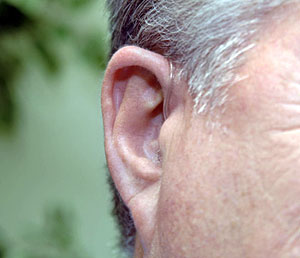Open Fitting Directional Microphone Hearing Aid
Feedsee Accessibility : Open Fitting Directional Microphone Hearing Aid : Corrects voices in front of the wearer while reducing noises from behind
Directional microphones play a crucial role in modern hearing aids by enhancing the user's ability to focus on specific sound sources, particularly in noisy environments. The basic concept behind directional microphones is to enhance sounds coming from a particular direction, typically from the front, while suppressing sounds from other directions.
Directional Hearing Aids in the Past
 In 2005, the HearPod Directional Mic Open Fitting hearing aid was a behind-the-ear device that provides directional microphone capability in an open fitting and cosmetically discrete design. Directional microphones improve the wearer's ability to understand speech by focusing correction on voices in front of the wearer while reducing noises from behind. Open fitting means the hearing aid allows the equalization of pressure inside the ear canal, eliminating the annoying barrel sound so common with many hearing aids. Digital technology allowed for an extremely slim and compact design. The anatomical shell was molded of clear acrylic, making the aid appear even smaller. It also means the aid was better able to blend with the user's skin tone.
In 2005, the HearPod Directional Mic Open Fitting hearing aid was a behind-the-ear device that provides directional microphone capability in an open fitting and cosmetically discrete design. Directional microphones improve the wearer's ability to understand speech by focusing correction on voices in front of the wearer while reducing noises from behind. Open fitting means the hearing aid allows the equalization of pressure inside the ear canal, eliminating the annoying barrel sound so common with many hearing aids. Digital technology allowed for an extremely slim and compact design. The anatomical shell was molded of clear acrylic, making the aid appear even smaller. It also means the aid was better able to blend with the user's skin tone.
This feature is especially beneficial in situations where the user is trying to listen to a single person's speech amidst a noisy background, for instance, in a crowded restaurant or at a social gathering.
Directional Hearing Aids Today
In a typical directional microphone setup in a hearing aid:
- Dual-Microphone System: The hearing aid employs at least two microphones, usually positioned a short distance apart from each other on the hearing aid. The close proximity yet distinct positions allow the microphones to capture sound waves at slightly different times.
- Sound Processing: The hearing aid's digital processor analyses the time and level (intensity) differences in the sound received by the two microphones.
- Directional Amplification: It then amplifies the sound coming from the front (where the person wearing the hearing aid is usually focusing their attention) and reduces the noise from the sides and back.
- Adaptive Directionality: Some advanced hearing aids have adaptive directional microphones. These automatically adjust the direction of maximum amplification or sensitivity based on the environment. For instance, if the desired speech is coming from the side rather than from the front, the hearing aid can adapt to this.
By employing these techniques, directional microphones can significantly enhance the signal-to-noise ratio, making it easier for the user to focus on the sounds they want to hear and lessening the impact of unwanted background noise. However, like any technology, they are not perfect and may not entirely eliminate difficulties in noisy environments.